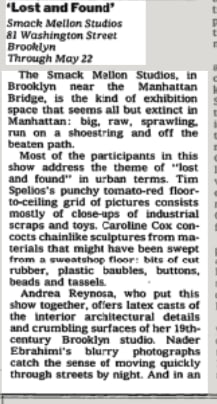'Lost and Found'
Smack Mellon Studios
81 Washington Street
Brooklyn
Through May 22
The Smack Mellon Studios, in Brooklyn near the Manhattan Bridge, are the kind of exhibition space that seems all but extinct in Manhattan: big, raw, sprawling, run on a shoestring and off the beaten path.
Most of the participants in this show address the theme of ''lost and found'' in urban terms. Tim Spelios's punchy tomato-red floor-to-ceiling grid of pictures consists mostly of close-ups of industrial scraps and toys. Caroline Cox concocts chainlike sculptures from materials that might have been swept from a sweatshop floor: bits of cut rubber, plastic baubles, buttons, beads and tassels.
Andrea Reynosa, who put this show together, offers latex casts of the interior architectural details and crumbling surfaces of her 19th-century Brooklyn studio. Nader Ebrahimi's blurry photographs catch the sense of moving quickly through streets by night. And in an evocative installation made from sculptures, film and projected shadows, David Baskin has created a miniature tableau of burning houses, with faces half hidden in the flames.
Other works move away from the city. Stephan Crasneanski displays photographs he took in Myanmar, India and Brazil in a pictorial essay about third-world cultures touched by scientific and touristic predation. Kate Yourke combines living plants, a humidifier and projected images of butterflies to build a tiny tropical Paradise Regained within the confines of a darkened room.
The strongest impact is made by the work of Harmony Hammond, an influential feminist artist and writer whose career began in New York in the early 1970's, and who now lives in New Mexico. In canvases covered with straw and scraps of linoleum flooring from abandoned Southwestern farmhouses, blood-red paint and explicitly sexual symbols, Ms. Hammond has created implied narratives of innocence lost through political, domestic and psychological violation. Her large-scale, materially dense work, too seldom seen in New York, needs breathing room to make its full effect, and it gets that here, in what amounts to an absorbing and ambitious one-person-show-within-a-show. HOLLAND COTTER
...
Read full article at nytimes.com.

